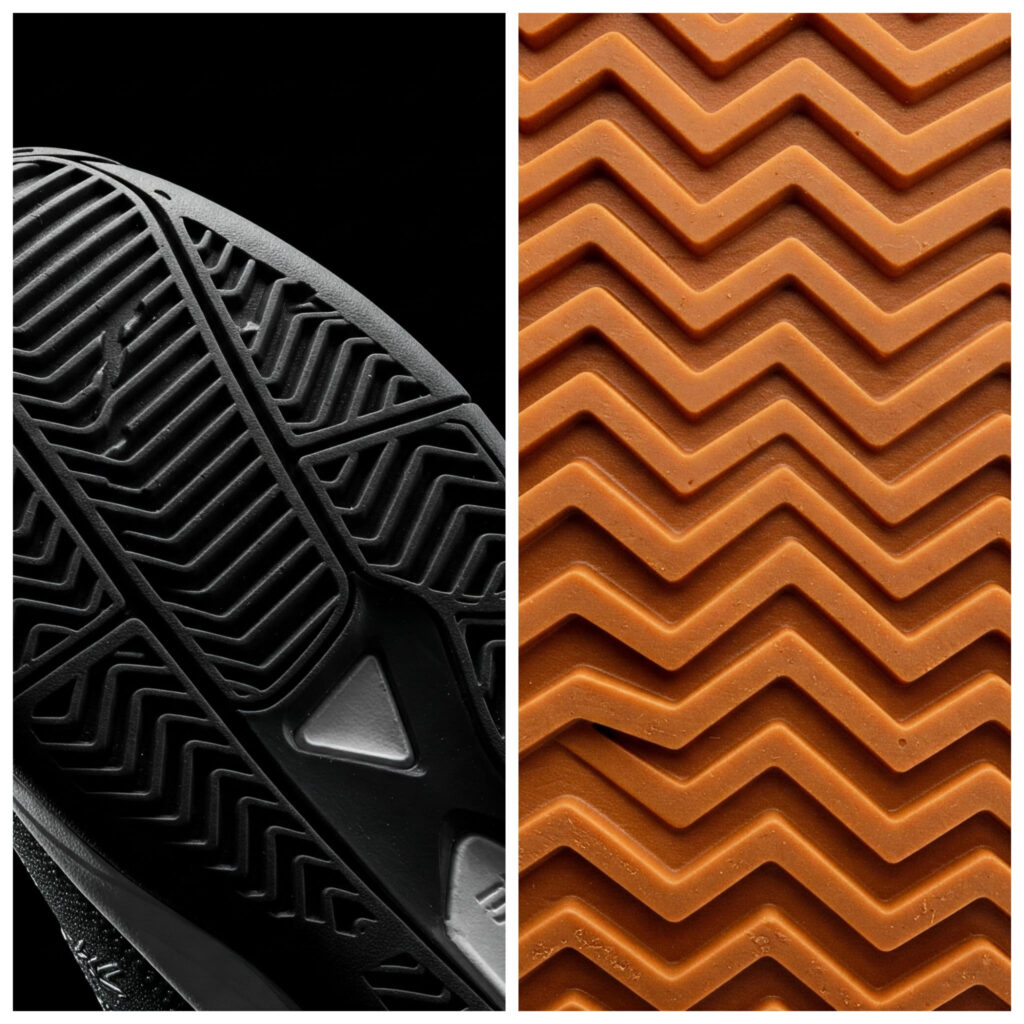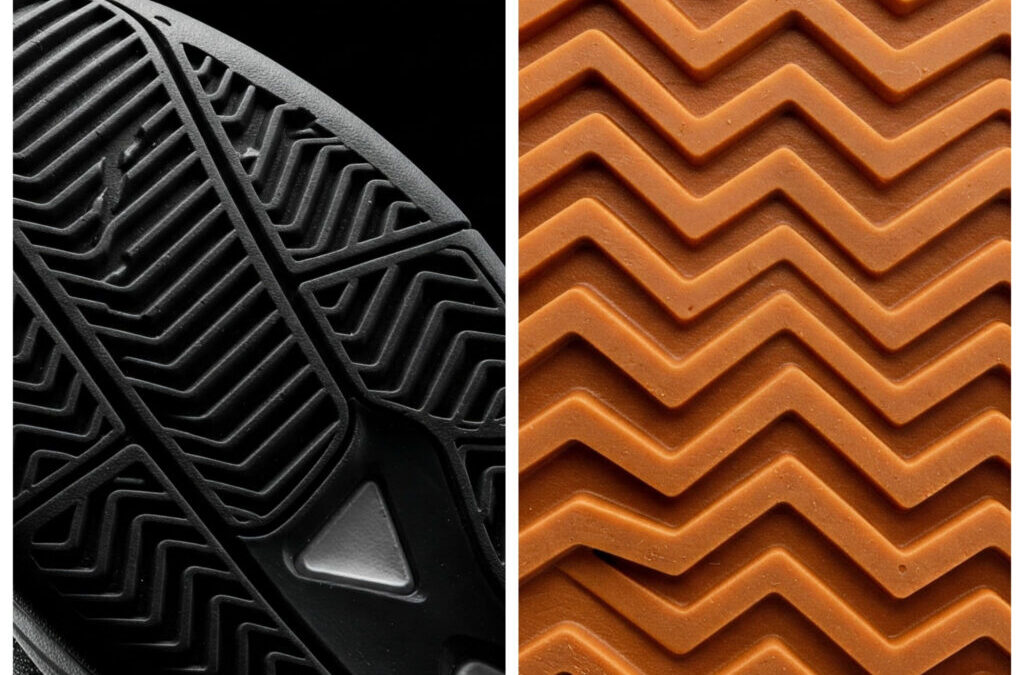
Selecting the right the right Tennis shoe
Stepping onto the court with the wrong footwear is like trying to paint with the wrong brush – you might get the job done, but the results will likely be less than ideal, and you risk damaging your tools (in this case, your body and losing the match and performing badly). Tennis, a dynamic sport demanding speed, agility, quick changes in direction, and explosive movements, places significant stress on the feet, ankles, and knees and entire kinetic chain.
Choosing the right tennis shoe, tailored to the playing surface and your unique biomechanics and playing style, is therefore paramount not only for performance enhancement but also for injury prevention and long-term foot health and Tennis wellness .
The three primary tennis court surfaces – clay, hard, and grass – each present distinct challenges and require specific shoe characteristics. Understanding these differences and how they interact with your individual foot mechanics is the first step towards making an informed decision.
The Surface Matters: Understanding the Demands
Clay Courts: These softer surfaces allow for more sliding, particularly when approaching the ball. The loose aggregate requires shoes with a full herringbone (zigzag) outsole pattern. This design prevents clay from packing into the treads, ensuring optimal grip for lateral movements and controlled slides.
Hard Courts: These are the most common and brutal surfaces, offering high friction and minimal give. Shoes designed for hard courts prioritize durability, cushioning for impact absorption, and a modified herringbone or multi-directional tread pattern that balances grip and allows for pivots.
Grass Courts: The fastest surface, grass demands shoes with a nubbed or pimpled outsole. These small protrusions provide traction on the slippery surface while minimizing damage to the delicate turf. Lateral movement is less frequent on grass, with a greater emphasis on quick forward and backward sprints.
Beyond the Surface: Recognizing Individual Differences
While surface-specific features are important, the “best” tennis shoes are ultimately subjective and depends on individual biomechanical factors:
- Foot Arch Type:
- Pronated (flat) feet: Tend to roll inward excessively during movement. These individuals often benefit from shoes with strong medial support and stability features to control pronation and prevent overstressing the inner ankle and knee.
- Neutral arches: Exhibit a healthy amount of pronation. These players generally have more flexibility in shoe selection but still require adequate cushioning and support.
- Supinated (high) arches: Have limited inward roll and may experience less shock absorption. Shoes with ample cushioning and flexibility are often recommended to compensate for the lack of natural pronation.
- Body Weight and Playing Style: Heavier players and those with aggressive, powerful playing styles generate more impact forces and may require shoes with greater cushioning and stability. Players who prioritize speed and agility might prefer lighter, more flexible options.
- History of Injuries: Individuals with previous ankle sprains, knee pain, or plantar fasciitis may need shoes with specific support features or orthotic compatibility.
The Benefits of Proper Shoe Selection
Choosing the right tennis shoes yields a multitude of benefits:
- Enhanced Performance: Surface-specific outsoles provide optimal grip and allow for quicker, more efficient movements. Proper support and stability facilitate confident changes in direction and powerful pushes off the ground. Lighter shoes can contribute to faster footwork and reduce fatigue.
- Improved Comfort: Well-cushioned shoes absorb impact forces, reducing strain on joints and muscles, leading to greater comfort during long matches and training sessions. A proper fit prevents blisters, chafing, and other discomfort.
- Reduced Risk of Injury: This is perhaps the most significant benefit. Shoes that provide adequate support and stability, tailored to individual biomechanics and playing surface, can mitigate the risk of common tennis-related injuries such as:
- Ankle sprains: Proper lateral support and a stable platform can help prevent excessive ankle roll.
- Knee pain (e.g., patellofemoral pain syndrome): Adequate cushioning and controlled pronation can reduce stress on the knee joint.
- Plantar fasciitis: Good arch support can alleviate strain on the plantar fascia, the thick band of tissue on the bottom of the foot.
- Stress fractures: Impact absorption provided by appropriate cushioning can help prevent repetitive stress injuries in the bones of the foot and lower leg.
Health and Injury Effects of Improper Footwear
Playing in the wrong tennis shoes can have detrimental effects:
- Increased Risk of Injuries: As mentioned above, inadequate support, cushioning, or inappropriate outsole patterns can significantly elevate the likelihood of various musculoskeletal injuries. For instance, wearing hard court shoes on clay can lead to slips and falls, while using clay court shoes on hard courts can result in excessive friction and potential ankle or knee strain due to the lack of give.
- Compromised Performance: Lack of proper grip can hinder agility and speed, while insufficient cushioning can lead to fatigue and discomfort, ultimately impacting performance.
- Development of Foot Problems: Over time, consistently wearing inappropriate footwear can contribute to the development of chronic foot issues such as bunions, hammertoes, and nerve compression.
Performance Benefits Backed by Science
Research supports the link between footwear and athletic performance and injury prevention. Studies have shown that:
- Surface-specific traction: Outsole design significantly affects traction and stability on different court surfaces, influencing agility and the ability to generate force effectively ([1]).
- Cushioning and impact absorption: Adequate shoe cushioning reduces impact forces transmitted to the lower limbs, potentially decreasing the risk of stress-related injuries ([2]).
- Foot biomechanics and shoe design: Matching shoe features to an individual’s foot type and biomechanics can improve comfort, reduce fatigue, and potentially enhance performance by promoting more efficient movement patterns ([3]).
Making the Right Choice: A Practical Guide
Selecting the proper tennis shoes requires a specific approach:
- Identify Your Primary Playing Surface: This will narrow down the essential outsole characteristics.
- Understand Your Foot Type: Consider getting your gait analyzed at a specialty running or tennis store. Wetting your foot and observing the footprint can also provide clues about your arch type.
- Consider Your Playing Style and Weight: More aggressive players or heavier individuals may need more supportive and cushioned options.
- Try Before You Buy: Always try on shoes with the type of socks you would wear on the court. Walk, jog, and make lateral movements in the store to assess comfort and support.
- Seek Expert Advice: Consult with professionals at specialized sports stores who can provide personalized recommendations based on your needs and playing style.
- Replace Regularly: Tennis shoes lose their cushioning and support over time and with use. Replace them every 6-12 months depending on your playing frequency.
Investing in the right tennis shoe is an investment in your performance, comfort, and long-term health and tennis wellness. By understanding the demands of different court surfaces, recognizing your individual biomechanical factors, and considering the scientific evidence, you can make an informed decision that will allow you to move confidently and safely on the court, ultimately enhancing your enjoyment of the game and minimizing the risk of injury. So, take the time to find your perfect footing – your body will thank you for it.
References:
[1] Hennig, E. M., Valiant, G. A., & Cavanagh, P. R. (1987). The effect of shoe surface interaction on the kinematics of running. Journal of Biomechanics, 20(10), 969-976.
[2] Nigg, B. M. (2010). Impact forces in running. Current Opinion in Orthopaedics, 21(2), 135-140.
[3] Stacoff, A., Reinschmidt, C., Nigg, B. M., van den Bogert, A. J., & Lundberg, A. (2000). Effects of shoe construction on skeletal movement during running. Medicine and Science in Sports and Exercise, 32(9), 1592-1597.
Shop Tennis Equipment :
https://www.amazon.com/shop/ranilharshana/list/1A104W2N5FIHY?ref_=aip_sf_list_spv_ofs_mixed_dShop Tennis Goods :
Shop Tennis Books : https://www.amazon.com/shop/ranilharshana/list/KPDXGXUSWV2L?ref_=aipsflist
Tennis Fitness Book
https://www.amazon.com/dp/B0DPL48X51
Tennis Performance Book


